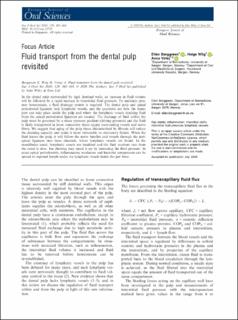| dc.contributor.author | Berggreen, Ellen | |
| dc.contributor.author | Wiig, Helge | |
| dc.contributor.author | Virtej, Anca | |
| dc.date.accessioned | 2021-02-24T14:24:12Z | |
| dc.date.available | 2021-02-24T14:24:12Z | |
| dc.date.created | 2021-01-29T13:55:45Z | |
| dc.date.issued | 2020-10 | |
| dc.identifier.issn | 0909-8836 | |
| dc.identifier.uri | https://hdl.handle.net/11250/2730186 | |
| dc.description.abstract | In the dental pulp surrounded by rigid dentinal walls, an increase in fluid volume will be followed by a rapid increase in interstitial fluid pressure. To maintain pressure homeostasis, a fluid drainage system is required. The dental pulp and apical periodontal ligament lack lymphatic vessels, and the questions are how the transport can take place inside the pulp and where the lymphatic vessels draining fluid from the apical periodontal ligament are located. The drainage of fluid within the pulp must be governed by a tissue pressure gradient (driving pressure) and the fluid is likely transported in loose connective tissue (gaps) surrounding vessels and nerve fibers. We suggest that aging of the pulp tissue characterized by fibrosis will reduce the draining capacity and make it more vulnerable to circulatory failure. When the fluid leaves the pulp, it will follow the nerve bundles and vessels through the periapical ligament into bone channels, where lymphatic vessels are found. In the mandibular canal, lymphatic vessels are localized and the fluid washout rate from the canal is slow, but chewing may speed it up by increasing the fluid pressure. In acute apical periodontitis, inflammatory mediators and bacterial components can be spread to regional lymph nodes via lymphatic vessels inside the jaw bone. | en_US |
| dc.language.iso | eng | en_US |
| dc.publisher | Wiley | en_US |
| dc.rights | Attribution-NonCommercial-NoDerivatives 4.0 Internasjonal | * |
| dc.rights.uri | http://creativecommons.org/licenses/by-nc-nd/4.0/deed.no | * |
| dc.title | Fluid transport from the dental pulp revisited. | en_US |
| dc.type | Journal article | en_US |
| dc.type | Peer reviewed | en_US |
| dc.description.version | publishedVersion | en_US |
| dc.rights.holder | Copyright 2020 the authors | en_US |
| cristin.ispublished | true | |
| cristin.fulltext | original | |
| cristin.qualitycode | 2 | |
| dc.identifier.doi | 10.1111/eos.12733 | |
| dc.identifier.cristin | 1882491 | |
| dc.source.journal | European Journal of Oral Sciences | en_US |
| dc.source.pagenumber | 365-368 | en_US |
| dc.identifier.citation | European Journal of Oral Sciences. 2020, 128 (3), 365-368 | en_US |
| dc.source.volume | 128 | en_US |
| dc.source.issue | 3 | en_US |

